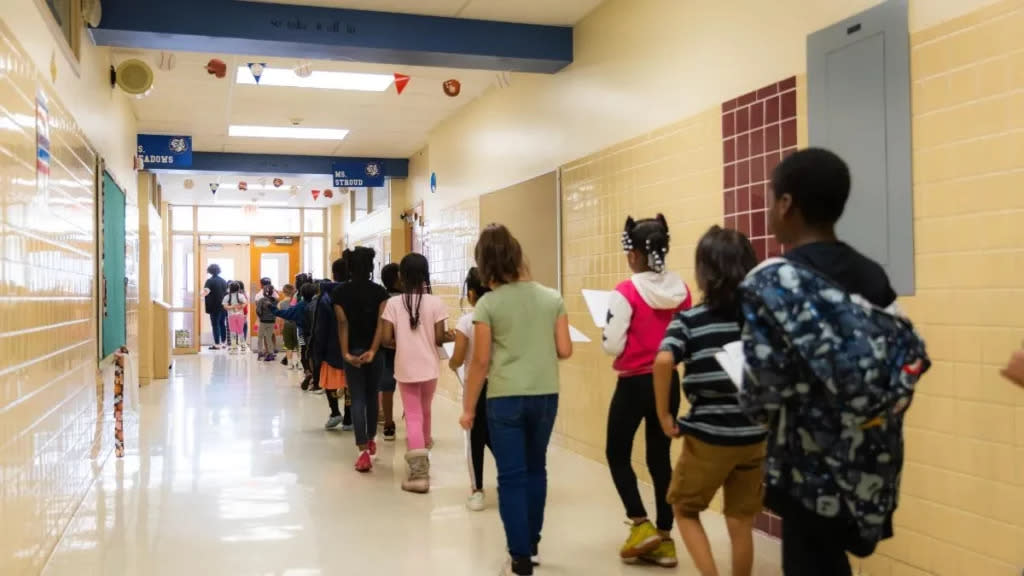Kansas City talked about shutting these schools down. Now, they’re growing

A large first grade class heads outdoors on May 7 at George Melcher Elementary School in Kansas City, Missouri. The school has seen rapid enrollment growth this year (Zach Bauman/The Beacon)/
The line of children filing down the hallway of George Melcher Elementary School in Kansas City seemed endless.
“This is one first grade class,” Principal LaKeisha Paul said.
“How many kids do you have?” she called to the teacher. The answer was 32.
It’s hard to keep track. New students have continued to pour into Melcher throughout the school year.
The kindergarten-through-sixth grade school went from 298 students in early September to 413 in mid-April, a nearly 39% increase.
Growth didn’t stop there. On May 7, Paul said the school had seen 95 new students since April 1. Eight more had arrived that day.
“Right now, we’re just trying to get them in, let them know that they’re safe, feed them lunch and start planning for next year,” she said.
About 18 months ago, Melcher was on a list of 10 schools that the district considered closing, hoping to spend more money on academics and activities rather than buildings. Declining enrollment — and projections that the area’s population would drop — figured prominently.
Now, Melcher strains to fit in an ever-growing number of students.
The school offers a stark example of growing enrollment across the district throughout the 2023-24 school year, especially in several schools the district had considered shuttering.
A nearly 80% increase in the number of new students arriving from other countries compared to last year fueled much of the growth.
Adding about 970 K-12 students — a 7% increase — between September and mid-April has upended the conversation in the district, Deputy Superintendent Derald Davis said.
“It lessens the chance that we need to consider any consolidations,” he said. “If schools are filling up and bursting at the seams, we’ll actually have to have a different conversation around possibly opening up another school.
Challenges for schools
When new students arrive in Melcher, the school has to address their medical and mental health concerns as well as squeezing them into classrooms and adding more children for teachers, counselors and administrators to look after, Paul said.
That can be especially true if the family is brand-new to the U.S.
“We had a little boy, just got here, speaks no English, missing his parents, and he had an abscessed tooth,” she said. “(The) fourth grader cried for days and days with the nurse’s office just trying to get him into a dentist because they’d come with no insurance. It’s like a whole ordeal. … We’re just kind of making it work right now.”
The school has leaned on district language resources to communicate with new families in Spanish, Arabic and Swahili. One family spoke a language rare enough that the school had to specially download it into Google Translate, Paul said.
Class sizes are another concern.
Missouri sets standards, from up to 25 per class for kindergarten through second grade to as many as 33 for high school. KCPS tries to aim lower, especially for schools that haven’t historically performed well, Davis said.
But when extra students show up partway through the year, schools have to surpass the caps or find workarounds.
The state limits represent “a strong suggestion,” Paul said. But when new students keep arriving, “what do you do at the end of the year? You can’t just hire a teacher.”
Davis said the district has made overflow plans, where some students are sent outside their neighborhood to a school with more room.
At Melcher, Paul no longer has an instructional coach — someone who mentors teachers to improve their work. She made that person a second grade teacher to split two huge classes into three smaller ones.
Next year, Davis said, the district will be able to plan for hiring enough teachers.
He said KCPS is expecting to see more growth based on current trends, predictions of how many refugee children will arrive and plans to make the district more appealing to families, such as improving transportation and fixing air conditioning problems.
While the growth is an overall positive sign that families trust the district with their children, it puts stress on teachers, said Jason Roberts, president of KCPS’ teachers union.
“I am thankful that we did not close 10 schools, because we have nowhere to put the children now,” he said. “In the midst of a teacher shortage, there aren’t people to fill classrooms, which means classrooms are already large, and they’re getting larger. And I think that’s the deficit that we have to fix. We have to be prepared for a solid influx of kids every year.”
Benefits for KCPS
KCPS has made it clear that improving enrollment is central to the district’s success, especially if the public doesn’t want it to close schools.
Having more students in each building is more financially efficient, allows for programs such as sports teams that work better in larger schools and could justify keeping more schools open.
Enrollment has been a struggle.
Competition with charter schools — public schools that are free to attend but operate independently of the district — helped shrink KCPS. The district had more than 36,000 students in the mid-1990s but less than 15,000 before the COVID-19 pandemic.
Like most districts, KCPS saw a drop in enrollment in 2020 — about 5% — as some families opted for private school or homeschooling, delayed enrolling young children or fell off the radar.
During the 2021-22 school year, charter school enrollment exceeded the district’s.
In early 2022, the district regained full accreditation from the state for the first time in a decade. Small increases in fall enrollment followed in 2022 and 2023, but not enough to bring the district back to pre-pandemic levels.
That suddenly changed with the 7% K-12 enrollment growth during the school year that’s wrapping up now. When including pre-kindergarten students, enrollment increased by nearly 1,250, or about 9%.
In addition to fending off school closures, enrollment growth feels like a vote of confidence, Davis said. The district plans to ask voters to approve a bond to fund building improvements, something that hasn’t happened in nearly 60 years.
“We want to be the premiere destination for a quality education in Kansas City,” Davis said.
Why KCPS enrollment is growing
For years, it seemed the number of children in the area was declining, said Ike Graham, president of the Vineyard Neighborhood Association.
With talk of KCPS closing Melcher and the Missouri State Board of Education shutting down Genesis School, he worried that pattern would continue.
“If I still had a family with kids,” Graham said, “I’d move where the school is.”
Recently, Graham said he’s seeing quite a few people move into the neighborhood, though it wasn’t obvious to him that the number of children specifically had increased.
Some are returning to the city from the suburbs or are drawn by affordable housing, such as new duplexes, Graham and neighborhood association secretary Virginia Flowers said.
Paul, the Melcher principal, said the school’s growth could be driven by rental prices and the draw of community.
“A lot of our Hispanic families are moving because they already have family in the area,” Paul said.
Melcher is tucked away in a residential neighborhood of small, ranch-style homes, about a block away from 39th Street and about half a mile from where it intersects with Emanuel Cleaver II Boulevard.
It serves the neighborhoods of Vineyard, Vineyard Estates, Dunbar, Knoches Park, East Side and Palestine West/Oak Park Northeast.
Some students transfer from charter schools, but most families are coming from other districts, states and countries, Paul said.
KCPS shared data that show how students enrolled at the end of the 2022-23 school year ended up in the district. Then it compares that to how current students, or those who graduated this year, got there.
The largest group of new students moved in from elsewhere in Missouri. But the biggest change from last year was the number of students coming in from outside the U.S.
That group went from 400 students last year to 717 students this school year, about a 79% increase.
KCPS also saw about 160 more students move in from within the state compared to last year. Increases in students transferring from out of state, private school and homeschooling were smaller.
It’s not clear from the data what proportion of students from in-state come from charter schools, elsewhere in the metro or other regions of Missouri.
Area school districts, including North Kansas City, Hickman Mills, Center, Shawnee Mission, Olathe and Kansas City, Kansas, said enrollment had been steady or shared data showing only small percentage changes during the school year. The Independence district did not respond.
Davis said KCPS’ public engagement, such as conversations about proposed school closures and the district’s long-term plan, have improved awareness about what the district has to offer and led to more local families choosing KCPS.
But there’s no noticeable trend of families leaving local charter schools en masse, said Leslie Kohlmeyer, executive director of Show Me KC Schools.
Her nonprofit helps families navigate their education options including charter and private schools and runs School App KC, an application used by most area charter schools and several private schools and pre-K programs. The number of families using that application has stayed steady.
“Probably both (traditional public and charter) sectors are increasing in numbers and not one pulling from the other,” she said.
Kohlmeyer has noticed some families taking a strong stance in favor of KCPS.
“Millennials and Gen Z are very dedicated to public education, which for them doesn’t include charters,” she said.
Which KCPS schools are growing in enrollment
The schools that grew most during the school year were generally located in the east-central or northeast areas of the district.
Like Melcher, many of them were also on a school closure list before the district reversed course.
That includes Faxon Elementary School, which covers the Santa Fe and Squier Park neighborhoods and grew by nearly one-third during the school year. Wheatley, James and Whittier elementary schools and Central High School grew 10% to 20%.
Other schools that grew at a similar rate — but hadn’t been at risk of closure — include Trailwoods, Garfield and J.A. Rogers elementary schools, Northeast and Central middle schools and East High School.
Some of KCPS’ small special programs, such as Evening Academy and alternative schools, grew by a dramatic percentage, and the district’s virtual academy saw a 29% increase.
Kohlmeyer, whose nonprofit is located in the historic northeast to better serve immigrant families, also said she’s noticed more of those families finding affordable housing farther south.
The district’s southernmost schools, Hartman and Hale Cook elementaries in Waldo, didn’t see the most dramatic growth, but Davis said that’s in part because they were already full at the beginning of the year.
While the district’s high schools generally have space to spare, Davis said full elementary schools could require the district to reopen a school.
“We are pretty much full on the southern end of town,” he said. “So if our northern schools and those in the central part of town began to show those same sort of numbers, we may be there fairly quickly.”
This article first appeared on The Beacon and is republished here under a Creative Commons license.


The post Kansas City talked about shutting these schools down. Now, they’re growing appeared first on Missouri Independent.

